UNITED STATES AND THE DEVELOPING WORLD
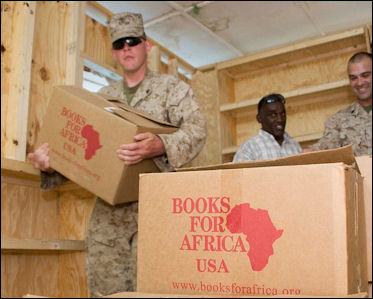
US Navy bringing educational books In 2006, U.S. Secretary of State Condoleezza Rice called for a “transformational” shift of diplomats from Europe and the developed world to the developing world and called for these diplomats to do more hands-on work with the local population to make the U.S. foreign service more relevant in a changing world in the 21st century.
The Bush administration promised to quadruple foreign aid to developing countries at an internationally agreed-upon target of 0.7 of GDP but failed to follow through with its promises. The Millennium Challenge — his administration’s poverty-fighting program for the developing world — took a long time to get off the ground.
In 2005, the United States gave poor countries $15 billion in foreign aid, roughly one 30th of the Pentagon budget and 0.16 percent of the United States’s GDP. Private donations by Americans to developing countries added another $6 billion.
The strategy of the Bush administration’s Millennium Challenge was not to dish out small amounts of money to every developing country but rather to give out larger amounts of money to a few nations that met certain criteria such as being well governed, showing commitment to free markets, demonstrating success at fighting corruption, and showing a willingness to invest in education, health care and programs that bring direct benefits to citizens.
U.S. Foreign Aid
Since the 1970s, foreign aid spending by the U.S. government has hovered around 1 percent of the federal budget. International assistance programs were close to 5 percent of the budget under Lyndon B. Johnson during the war in Vietnam, but have dropped since. Even so, John Norris wrote in the Washington Post, “In poll after poll, Americans overwhelmingly say they believe that foreign aid makes up a larger portion of the federal budget than defense spending, Social Security, Medicaid, Medicare, or spending on roads and other infrastructure. In a November 2010 World Public Opinion poll, the average American believed that a whopping 25 percent of the federal budget goes to foreign aid. The average respondent also thought that the appropriate level of foreign aid would be about 10 percent of the budget — 10 times the current level. Compared with our military and entitlement budgets, this is loose change. [Source: John Norris, Washington Post April 28, 2011, Norris is the executive director of the sustainable security program at the Center for American Progress]
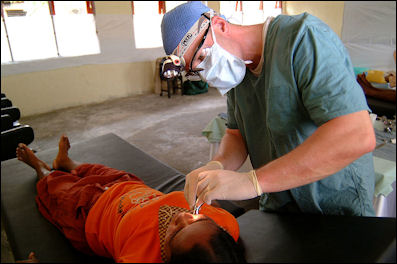
US dentist win an Indonesian woman Many Americans think we give aid so countries will do as we say. Norris wrote in Washington Post, “Ken Adelman, Reagan’s U.N. ambassador, was shocked when he showed up at the United Nations in 1981 to find that countries receiving U.S. development assistance didn’t always support Washington. As Adelman put it in a recent Foreign Policy article: “Did all that money buy America any love?” But foreign aid is not designed to make countries like us. The United States wants stable democratic partners that are reliable allies in the long run. Aid builds these relationships, even when the countries we help don’t support us in the short run. For example, the Reagan administration didn’t approve when Costa Rica inserted itself into multiple conflicts raging in Central America during the 1980s. But U.S. assistance to Costa Rica helped that nation become a champion of democracy and human rights as well as of regional trade agreements. Similarly, the United States and India were badly estranged at different points during the Cold War, but U.S. assistance to India helped spark the “green revolution” that prevented massive famine in the late 1960s. Today, India is one of America’s most important allies in Asia.” Defense Secretary Robert Gates noted im 2010: “Development contributes to stability. It contributes to better governance. And if you are able to do those things and you’re able to do them in a focused and sustainable way, then it may be unnecessary for us to send soldiers.”
In response to the notion that foreign governments waste the aid we give them, Norris wrote: “During the Cold War, some foreign aid was directed to friendly dictators with little regard for their own people, such as Zaire’s President Mobutu Sese Seko. Local corruption also swallowed assistance to Haiti after 2010's earthquake. But when aid is wasted, it’s more often a result of stateside congressional inefficiency. For example, Congress mandates that 75 percent of all U.S. international food aid be shipped aboard U.S. flagged vessels — ships registered in the United States. A study by several researchers at Cornell University concluded that this subsidy of elite U.S. shipping companies cost American taxpayers $140 million in unnecessary transportation costs during 2006 alone. The Government Accountability Office noted that between 2006 and 2008, U.S. food aid funding increased by nearly 53 percent, but the amount of food delivered actually decreased by 5 percent. Why? Because our food aid policies are swayed by an agribusiness lobby that stresses buying American, not buying cheaply.

American Humanitarian Aid in Kenya On countries becoming addicted to foreign aid and never graduating from it, Norris wrote, “The notion that poor countries are doomed to stay poor has always been part of the foreign aid debate in the United States. Nations across Latin America and Asia were dismissed in the 1960s as perennial basket cases, yet countries in both regions combined sensible reforms with a jump-start from U.S. assistance programs to achieve dynamic, lasting growth. According to the United States International Trade Commission, 10 of the 15 largest importers of American goods and services, including countries such as South Korea, Taiwan and Singapore, graduated from U.S. foreign aid programs.
Food Aid from the United States
The United States provides half the world’s food aid. Legal restrictions and bureaucracy in the United States require much of the aid to be the in form of American crops. Texas-grown sorghum can take as long as six months to reach places in sub-Sahara Africa, arriving long after it is most desperately needed, in the worst cases, leaving many people dead. On top of that prolonged presence of U.S. Food aid can overwhelm local markets and drives prices down, hurting local farmers. [Source: Philip Gourevitch, The New Yorker, October 11, 2010]
Typically with American food aid the U.S. government buys food grown in the United States. The food is shipped overseas mostly on American-flagged ships. At its destination the food is donated to nonprofit aid groups. A spokesman for Oxfam America told U.S. News and World Report, “While America provides half of the world’s food aid, this generosity is undermined by legal restrictions and bureaucracy, as food must be purchased in the United States and transported on U.S.-flagged ships.” The policy is in place in part to help American farmers and shippers.
Aid groups have criticized the system as being inefficient as well as unfair. CARE and the Catholic Relief Services — who rank first and second in money raised under the current system — complain they recover only 70 to 80 percent of what the United States paid for commodities and shipping. In 2007, CARE turned down $45 million of food aid from the United States.
Peace Corps
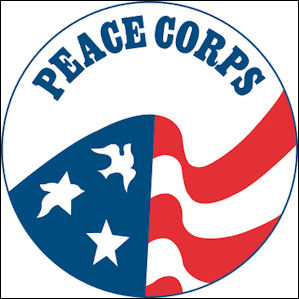
Peace Corps logo Peace Corps volunteers from the United States and similar aid agencies in other countries have been involved in reforestation, agriculture, medicine and education. They have helped people to construct irrigation systems, concrete communal laundry areas and tube wells; helped them set up small businesses and credit unions; and taught villagers how to build latrines with 112 mud bricks, at least 50 feet downhill from their homes, and make more efficient cooking stoves with a circular pieces of metal and some rocks that helps trap heat instead of letting it escape.
Many Peace Corp volunteers teach English or teach local teachers how to teach English. The volunteers are largely left on their own with little supervision. Many quit before they fulfill their two year obligation. Some local people complain they have too little experience to provide much help.
More than 200,000 volunteers have served in the Peace Corps in 139 countries. The Peace Corps sent 7,671 volunteers abroad in 2009 down from a peak of 15,556 in 1966.
Book: “When the World Calls: The Inside Story of the Peace Corps and Its First Fifty Years” by Stanley Meisler, a former Los Angeles Times staff writer and deputy director of the Peace Corps office of evaluation and research.
History of the Peace Corps
The Peace Corps was founded in 1961, when John Kennedy was president of the United States, as an agency of the Department of State. It was first headed by Kennedy's brother-in-law Sergeant Shriver. The volunteers are generally recent college graduates or people with skills useful in developing countries. The receive a small salary and are required to make a two year commitment. Other countries such as Britain and Japan have organizations similar to the Peace Corps. In Britain there is the Volunteer Service Organization (VSO). Japan has the Japan Oversea Cooperation Volunteer (JOCV).
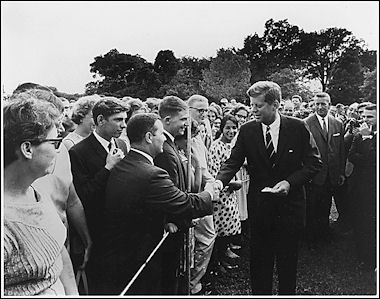
Kennedy greeting Peace Corps volunteers in 1961 No one embodied the spirit of the Peace Corps better than Shriver Jr., who died in 2011 at the age of 95, six weeks before the Corps's 50th anniversary on March 1. Steven V. Roberts, a professor at George Washington University, wrote in the Washington Post, Sure, much of Shriver's influence flowed from his marriage to President Kennedy's sister Eunice; and some of his charisma was manufactured by the Kennedys' hyper-active myth-making machine. But the testimonials to Shriver after his death reveal his enduring influence. As Larry Koskin, a volunteer in the Philippines in the late '70s, told a Post reporter at Shriver's wake: "If you go to the Peace Corps building, his spirit is very much alive. You feel an incredible optimism for what is possible."
“The Peace Corps was a mindset,” Roberts wrote, “a value system, and its influence ranged far beyond the volunteers who actually joined. It symbolized Kennedy's call for national service and inspired a whole generation of our contemporaries to become public interest lawyers and public school teachers, political journalists and community organizers, dedicated advocates for civil rights, women's rights and human rights.
Stanley Meisler, author of a book about the Peace Corps, wrote in the Los Angeles Times, “It had so much pizzazz in the early days that newspapers proclaimed the names of new volunteers as if they had just won Guggenheim fellowships. Now, the number of volunteers — 8,655 — is about half of what it was at its highest in 1966, and not everyone knows the Peace Corps still exists...Shriver, who put the program together in six months — made the cover of Time in 1963.
Later there were political problems. “President Nixon tried to destroy it outright, mostly out of his deep antipathy toward a successfully fulfilled Kennedy campaign promise, but he only managed to bury it as part of another agency for 10 years,” Meisler wrote. “Then the Vietnam War crippled recruitment as many young Americans dismissed the Peace Corps as no more than the smile on the face of the American tiger. President Reagan dragged the Peace Corps into his foreign policy by using it to reward Honduras for harboring the right-wing Contras fighting the left-wing Sandinistas in Nicaragua.
In more recent years, the corps has grappled with different controversies. After the Cold War ended, an ambitious Peace Corps director, Paul Coverdell, distorted its mission, rushing hundreds of volunteers into Eastern Europe to teach capitalism and the language of capitalism, English. Some of the countries were so poor that there is no doubt they could have used volunteers, but it was hard to fathom what the Peace Corps was doing in great European cities such as Prague and Budapest.
Problems with the Peace Corps
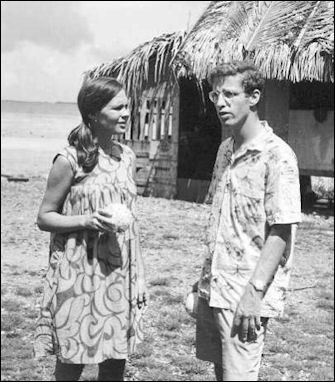
Peace Corps volunteers in 1968 Meisler wrote some volunteers "fell into the trap of living like a colonial." He recalled a "disconcerting" lunch in Cameroon when his host tinkled "a little bell to signal an African servant to patter in and clear the dishes." Others badly misread local customs. In another Cameroonian village a female volunteer waved casually at a young soldier and soon received a gift of eggs and potatoes, "the customary first step of a marriage proposal."
More seriously, the Corps has never resolved a basic contradiction. It was formed as an independent agency, separate from the State Department and clearly "not an instrument of foreign policy." But it has periodically become ensnared in politics, most notably during the Vietnam War. Applications plummeted, and those who did serve often turned strongly against their own government and their own agency. One disillusioned volunteer branded the Corps "a kind of graduate school for imperialism."
Michael Maren, a Peace Corps volunteer in the 1970s, wrote in “The Road to Hell”, his book about foreign aid, “In the post-Vietnam world, the Peace Corps offered us an opportunity to forge a different kind of relationship with the Third World, one based on respect,” he writes. But he soon began to wonder how respectful it is to send Western kids to tell the elders of ancient agrarian cultures how to feed themselves better. As he watched professional humanitarians chasing contracts to implement policies whose harm they plainly saw, he came to regard his colleagues as a new breed of mercenaries: soldiers of misfortune.
More recently, Meisler wrote, the corps has been publicly criticized for supposedly failing to protect female volunteers — 60 percent of those serving overseas — from sexual assaults and harassment. Based on Columbia University and Peace Corps statistics, the incidence of rape on college campuses is higher than in the corps. However, one rape victim came forward to accuse the corps of treating her as if she were at fault. Moreover, cultural attitudes make it difficult for female volunteers in some countries to avoid sexual harassment.
Improvements and Legacy of the Peace Corps
Stanley Meisler, author of a book about the Peace Corps, wrote in the Los Angeles Times, “Yet the Peace Corps, despite its loss of celebrity and size, has improved a great deal during its 50 years. It probably does a better job at one of its main goals: providing skilled manpower to poor countries in need. The volunteers are better trained than in the early years, arriving at their posts speaking not only the official language of the host countries but the local tribal language as well.
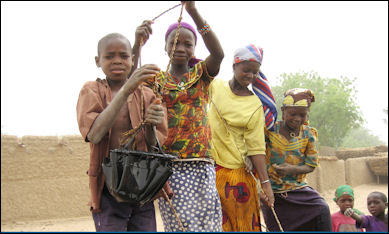
Peace Corp well project in Niger Moreover, the volunteers are better deployed. In the early days, a few towns had scores of Peace Corps volunteers — a single school in Ethiopia, for example, might have had a dozen volunteer teachers. Now, many volunteers are assigned to villages by themselves. The Peace Corps' longevity is a testament to a good idea, and the corps is surely President Kennedy's most enduring legacy. But its progress has never been guaranteed.
Fifty years on, what has the Peace Corps accomplished? It's possible to cite the pounds of fish sold or the pounds of honey produced under volunteer projects. But how do you measure the influence of an inspiring teacher? Or the effect on an impoverished teenage boy such as Alejandro Toledo, who, with volunteers' help, goes on to college and becomes the president of But there is no difficulty measuring the impact of the Peace Corps on the United States. Half a century after Kennedy's call, the Peace Corps' greatest achievement may be the volunteers themselves.
Peace Corps alumni include two U.S. senators — Chris Dodd of Connecticut and the late Paul Tsongas of Massachusetts — and nine members of the House of Representatives, as well as governors of Wisconsin and Ohio and the mayor of Pittsburgh. One Cabinet member was a volunteer: Donna Shalala, Health and Human Services secretary in the Clinton administration and now the president of the University of Miami. Ten other volunteers are presidents of universities and colleges.
More than 20 have served as ambassadors or assistant secretaries of State; others went on to become teachers, doctors, economic development specialists. The novelist Paul Theroux heads a long list of Peace Corps writers, and the roster of journalists includes Chris Matthews of MSNBC and George Packer and Peter Hessler of the New Yorker. The founders of Netflix and the Nature Co., and the board chairs of Levi Strauss and the Chicago Bears, were also volunteers.
Decline of the Peace Corps
In 2008 Christiane Amanpour illustrated America's declining role in the world by telling a foreign policy conference, "There was a Peace Corps." After the session a former volunteer named Jon Keeton angrily corrected CNN's chief foreign correspondent: "There still is a Peace Corps." As author Stanley Meisler recalls, "Amanpour blushed but pointed out that there must be something wrong if someone like herself did not realize the Peace Corps still existed." [Source: Steven V. Roberts, Washington Post, February 20, 2011]
Steven V. Roberts wrote in the Washington Post, “The Peace Corps is a forgotten player today, riding the far end of the government's bench and seldom getting into a game. Some years ago a State Department document referred to it as the "Peach Corps" and no one caught the error
China, Chinese Foreign Aid and the Developing World
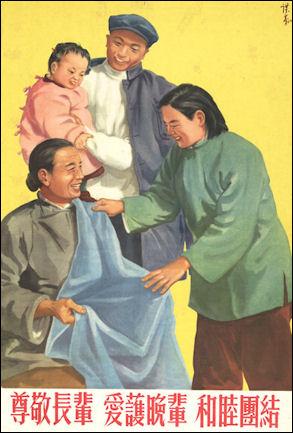
China is a key supporter of the Group of 77, a group of Third World countries — many of them in Africa — that wields power in the United Nations because of its numbers and is helped by China’s Security Council veto.
China’s foreign aid has swelled nearly 30 percent a year since 2004, and from 1950 through 2009 has totaled 256.2 billion yuan ($39.2 billion), China’s State Council Information Office the reported, its first on the subject. [Source: AP, April 22, 2011]
Chinese aid is evident in many parts of the developing world. It is building roads and railways around Africa, textile mills in Syria, cement plants in Peru and bridges in Bangladesh. While welcomed by recipient governments, it has drawn fire from the U.S. and other Western donors, who say Beijing's lack of transparency is contributing to corruption and mismanagement.
In April 2011, AP reported: “China defended its often-criticized role as a foreign aid donor, saying its assistance boosts developing countries and provides an alternative to Western donors who impose more conditions on recipients. China said its rise as an aid donor is a good development at a time when the global financial crisis is straining most other countries' spending.”
“While the report addresses some criticisms, saying Chinese projects employ local workers, it largely glosses over contentious issues. It lacks specifics on aid to particular countries and does not address complaints that many aid-backed projects require the use of Chinese contractors or are used to secure rights to oil, minerals or other natural resources. Still, the report marks a step toward transparency for a government that has largely refused to subject its aid program to international scrutiny.”
"It's a big step for them," said Deborah Brautigam, an expert on China-Africa relations at American University in Washington. "They're trying to figure out what it means to be a responsible, great power, and one of the things they've been getting beaten up about a lot is foreign aid." The report portrays China as a willing and reliable partner for the developing world, ready to grant assistance without "political strings attached" unlike Western donors who impose stringent conditions and whose own budgets are increasingly strained.
"Currently, the global development environment is very grim," the report said, pointing to the impact of the global financial crisis, climate change, energy security and other challenges. "China, as an important member of the international society, will ... gradually increase the input for external assistance," based on continued development of its economy, it said.
Problems with Chinese Overseas Development
The attitude among many recipient countries of Chinese foreign aid is mixed. Increasingly China is being seen more as a competitor than a partner. Yeah the recipient countries want the money and development, but are suspicious of Beijing’s ultimate goals and find the Chinese presence often undermines local industries.
John Pomfret wrote in the Washington Post, “China is a master at lowball financing, fashioning loans of billions of dollars at tiny interest rates that can stretch beyond 30 years. Financing, seemingly an arcane matter, can often account for 40 percent of the cost of a project....This has become a headache for Western competitors, especially members of the 32-nation Organization of Economic Cooperation and Development (OECD), which long ago agreed not use financing as a competitive tool.”
State-controlled Chinese companies such as Wuhan Iron and Steel and Chinese oil and gases companies are able to get an edge over foreign competitors by offering state-backed low-interest loans that are sometimes as low as 1 percent. Under OECD rules the United States and Europe have offer loans at market rates.
China has been praised for investing money in Africa rather than providing aid for programs that often don’t work. In October 2009, the leader of Rwanda said, “the Chinese bring what Africa needs: investment and money for government and companies. I would prefer the Western world would invest in Africa rather than hand out development aid.”
Some object to the way deals are secretly made, making it easy to bribe officials and jack up costs, producing debts that could be expensive to pay off in the future. Sometimes the aid that China provides is of questionable value and hints of corruption. For example China provided Namibia — an African country with just 2 million people and few paved roads — with $55.3 million scanners used to deter smugglers during a visit by Chinese President Hu Jintao. It just so happened that the scanners were provided by a company run run by Hu’s son in law and $4.2 million was deposited in the account of a company run by Namibia’s public service commissioner.

Peace Corps Map current and former participating nations
Washington Consensus Versus Beijing Consensus
Some refer to the Chinese economic model of relying on a strong authoritarian government to guide economic policy, allowing free markets but clamping down on human rights, as the Beijing Consensus. Cui Zhiyuan, a professor of public policy at Tsinghua University, told the Washington Post , “It is very possible that Beijing Consensus can replace the Washington Consensus — which emphasizes free trade, civilization, and prudent fiscal policy. Since the economic crisis the world doesn’t have as much confidence in the U.S. economic model as before.”
Ramesh Thakur wrote in the Daily Yomiuri, “Some countries have been trying to replace the Washington Consensus of free-market, deregulation, privatization, pro-trade and globalization policies with a Beijing Consensus of one-party, state-guided development, strictly controlled capital markets and an authoritarian decision-making process that can make tough strategic choices and long-term investments without being distracted by daily polls.[Source: Ramesh Thakur, Daily Yomiuri, November 26, 2010]
Columnist Anatole Kaletsky wrote in the Times of London that a leading U.S. diplomat told him that since the economic crisis in the late 2000s “developing countries have lost interest in the old Washington consensus that promoted democracy and liberal economics. Wherever I go in the world, governments and business leaders talk about the new Beijing consensus — the Chinese route to prosperity and power, The West must come up with a new model of capitalism that’s consistent with our political values. Either we reinvent ourselves or we will lose.”
The model of the Beijing Consensus is less painful for struggling economies in the developing world than the “shock therapy” prescribed by the IMF and Washington. It calls for gradual reforms, opening up to foreign trade while remaining self reliant and economic reforms having precedence over political reforms.
Barry Sautman, a political scientist at Hong Kong University of Science and Technology, told the Washington Post, the Beijing Consensus “takes seriously the aspirations of developing states often ignored or opposed in the West” such as “a more equitable international distribution of wealth and power.”
There has even been mentions of a Seoul Consensus, raised when South Korea hosted the G-20 meeting in November 2010, which shifts the spotlight away from foreign aid toward investments in infrastructure, education, health, technology and manufacturing. The Seoul Consensus puts the emphasis on private sector-led, poverty-reducing economic growth and job creation that is inclusive, sustainable, resilient and balanced.
Image Sources: Wikimedia Commons
Text Sources: New York Times, Washington Post, Los Angeles Times, Times of London, Yomiuri Shimbun, The Guardian, National Geographic, The New Yorker, Time, Newsweek, Reuters, AP, Lonely Planet Guides, Compton’s Encyclopedia and various books and other publications.
Last updated January 2012
